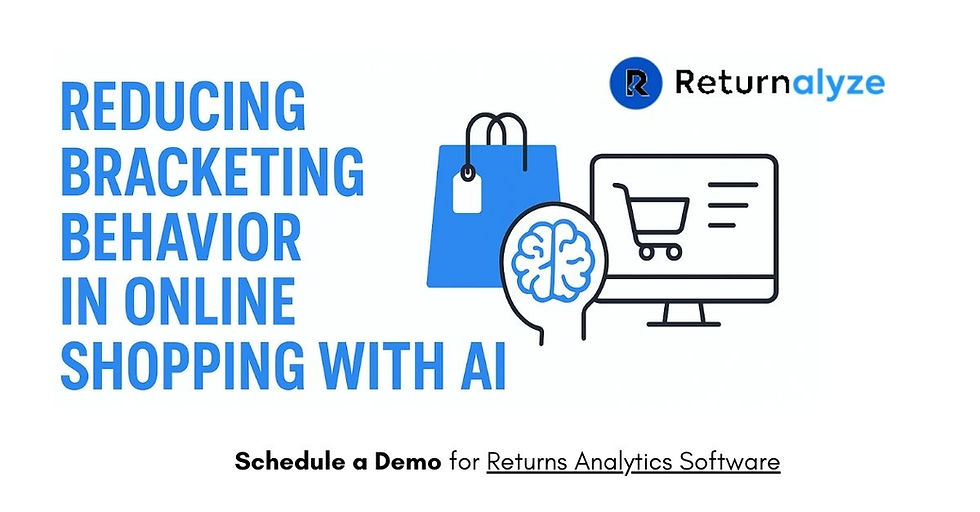Reduce Ecommerce Returns: Tips to Enhance Customer Satisfaction - Returnalyze
- returnalyze
- Nov 21, 2023
- 3 min read

In the dynamic realm of online commerce, the foundation of success lies in ensuring customer satisfaction. One significant factor that can either bolster or hinder this satisfaction is the rate of product returns. The process of handling returns can be costly and time-consuming for both the customer and the retailer.
To mitigate this challenge, it's essential to implement strategies that not only reduce ecommerce returns but also enhance customer satisfaction. In this comprehensive guide, we'll explore effective tips to achieve just that.
Understanding the Dynamics of Ecommerce Returns
The Impact on Customer Satisfaction
Returns, when mismanaged, can significantly impact customer satisfaction. Customers who encounter difficulties in returning products may become frustrated, leading to a negative perception of the brand.
Analyzing Common Reasons for Returns
Understanding the root causes of returns is the first step towards devising effective solutions. Common reasons include product dissatisfaction, sizing issues, and receiving damaged goods.
Strategies for Reducing Ecommerce Returns
Implementing Detailed Product Descriptions
Customers should have access to comprehensive information about products. Clear and detailed descriptions reduce the likelihood of misunderstandings and, subsequently, returns.
Size Guides for Apparel and Accessories
Sizing issues are a prevalent cause of returns, especially in the fashion industry. Providing accurate size guides helps customers make informed decisions, minimizing the chances of returns due to sizing discrepancies.
High-Quality Product Images
Visual representation matters. High-quality images showcasing products from various angles provide customers with a realistic view, reducing the chances of dissatisfaction upon receipt.
Interactive Customer Support
A responsive and interactive customer support system can address customer queries promptly. This proactive approach helps customers make informed decisions before purchasing, reducing the need for returns.
Streamlined Return Processes
A convoluted return process can be a major deterrent for customers. Simplifying and streamlining the return process fosters a positive customer experience, even when returns are necessary.
Personalization in Recommendations
Leverage data to provide personalized product recommendations. When customers feel a connection to suggested items, the likelihood of dissatisfaction and subsequent returns diminishes.
Bursting the Bubble of Returns: Strategies for Implementation
Leveraging Predictive Data Analytics
Predictive data analytics can be a game-changer in anticipating potential returns. By analyzing past data, retailers can identify patterns and proactively address issues that might lead to dissatisfaction.
Dynamic Pricing Strategies
Dynamic pricing can be used strategically to align with customer expectations. Offering discounts or incentives can dissuade customers from returning products.
Collaboration with Third-Party Services
Partnering with reliable third-party services for logistics and quality assurance can significantly reduce the chances of shipping errors and damaged goods, leading to fewer returns.
Perplexity and Burstiness in Customer Satisfaction
Maintaining a delicate balance between perplexity and burstiness in the customer satisfaction journey is crucial. Perplexity, in this context, refers to the variety of strategies employed, while burstiness signifies the impactful implementation of these strategies.
Take Charge of Customer Satisfaction Today!
In the world of e-commerce, where customer satisfaction reigns supreme, minimizing returns is a strategic imperative. By embracing detailed product information, proactive customer support, and innovative strategies, businesses can create a positive shopping experience that resonates with customers, ultimately reducing returns and enhancing satisfaction.
Ready to revolutionize your approach to ecommerce returns? Look no further than Returnalyze - your ultimate partner in reducing returns and elevating customer satisfaction. With cutting-edge product returns analytics and streamlined processes, Returnalyze empowers your business to proactively address return issues, optimize product offerings, and create a shopping experience that keeps customers coming back for more.
Don't just manage returns; conquer them with Returnalyze and redefine customer satisfaction in the world of ecommerce. Embrace the future of hassle-free ecommerce product returns and delighted customers – start your return management journey today!
FAQs - Reduce Ecommerce Returns to Enhance Customer Satisfaction
How can personalized recommendations reduce returns?
Personalized recommendations create a connection between customers and suggested products, increasing the likelihood of satisfaction and reducing returns.
Why is a streamlined return process important?
A simplified return process ensures a positive customer experience, even in the event of returns, enhancing overall satisfaction.
What role does dynamic pricing play in reducing returns?
Dynamic pricing can be used strategically to align with customer expectations, providing incentives that discourage returns.
How does burstiness impact customer satisfaction?
Burstiness, or impactful implementation of strategies, contributes to a positive customer experience, reducing the likelihood of returns.
Why is collaboration with third-party services beneficial?
Partnering with reliable third-party services ensures quality control and reduces the chances of shipping errors, minimizing returns.



Comments